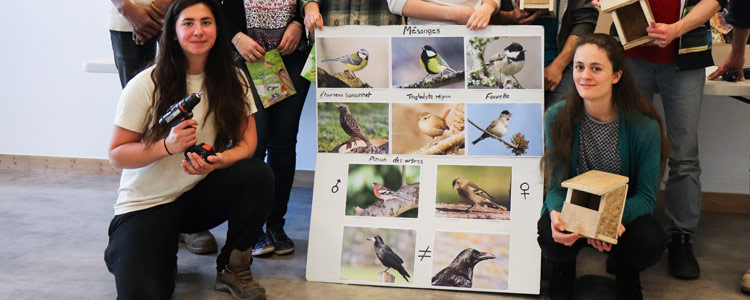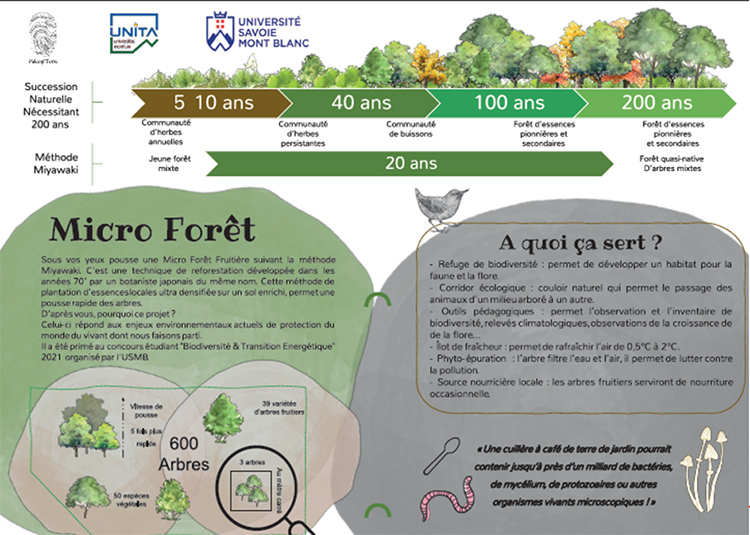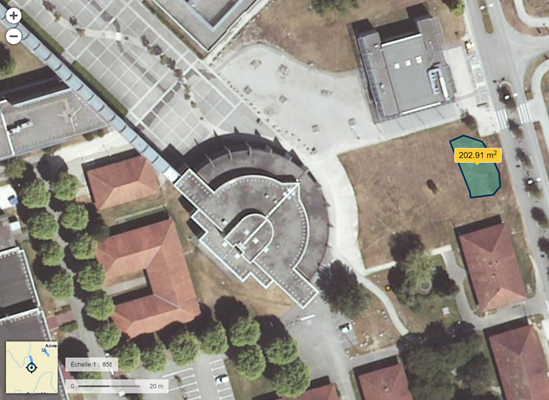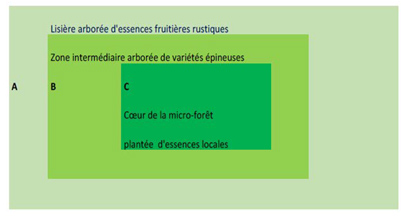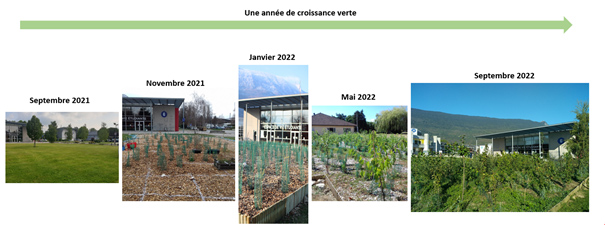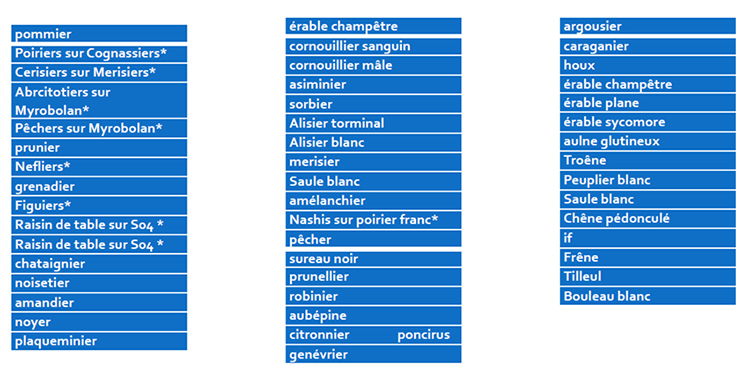Examples of actions carried out at USMB
- Biodiversity inventory on the Jacob-Bellecombette campus
- Nature activities by VALPESMONT Licence pro students: wetland restoration, nesting box workshop...
- DirPat installs 5 apiaries on the Jacob-Bellecombette campus
- Signing of a partnership with the LPO to label the Jacob-Bellecombette and Bourget-du-Lac campuses as an LPO refuge.
- Participatory biodiversity inventory on the Bourget-du-Lac campus
- Tutored project by VALPESMONT students on the green, blue and black fabric of the Bourget-du-Lac campus
- Nest box animation and conference organized by the LPO on the Bourget-du-lac campus
- Biodiversity 2020 action plan drawn up by the Heritage Department
- Planting a Miyawaki fruit micro-forest on the Le Bourget campus
The micro fruit forest on the Le Bourget University campus
Award-winning project in the 2021 "Biodiversity & Energy Transition" student competition organized by the USMB

The fruit and (or) food forest developed with the advent of permaculture. Permaculture is a systemic concept whose aim is to create "permanent" food-producing ecosystems. The idea here is to use these techniques to add a fruit-bearing perimeter to the micro-forest, i.e. a border of mainly fruit-bearing trees and shrubs. These trees will then benefit from the advantages generated by the micro-forest, and may have a nourishing function of additional interest to us.
- Soil analysis and enrichment.
A quick soil analysis enabled us to prepare the soil. The soil was prepared in the spring so that the trees could be planted in late autumn. It takes a good six months to start revitalizing the soil with a thick layer of shredded forest residue (RCW), compost and other green waste.
- The plantation.
We need to know which species are present in the vicinity of the planting site. These are essentially the plant species planted in the heart of the micro-forest. Breeding trees are identified and selected in the region. The idea is to work with a "grain library" characteristic of the terroir. The outer part, the edge, is planted (about two-thirds of the way along) with several hardy fruit varieties that are also local. One part, however, is planted "experimentally" with fruit species from warmer environments (almonds, pomegranates, hardy lemons, etc.), as they are likely to be better adapted to global warming, which is set to increase in the coming decades. The planting density is 3 plants per square metre (i.e. 600 trees for a typical 200 m2 plot). The density is the same throughout the plot.These two points are characteristic of MYAWAKI planting techniques, which are as close as possible to what occurs naturally.
Fig 3: Plantation structure
- Management
Management is minimal, as everything must be done to ensure that this micro-ecosystem regulates itself as quickly as possible. Management consists of checking that the planting material doesn't dry out during the first summer, and topping up the ground cover so that there is always sufficient thickness to keep it moist and full of life. Fruit-bearing species around the perimeter may be pruned to shape during the first three years.
A haven of freshness in a highly urbanized area.
The density of planting (3 trees per m2) provides a refuge for numerous animal species, large and small (mammals, birds, reptiles, insects, etc.). What's more, its central location in an urbanized area with a tree-lined perimeter means that this biodiversity refuge acts as an ecological corridor for animal species needing to move around.
Naming some fruit trees
- Latin: Malus pumila
- symbolic :
- Preference: promises a beautiful fruit from its flower
- beliefs // mythology :
- The dragon Ladon and the Hesperides, daughters of Atlas, protect the precious hidden apples, which are the secret of beauty and immortality for the gods who eat them. Hercules must bring back "these golden apples" to complete the 12 labors. He asks Nereus, the sea god, to show him the way. Compelled, he directs him to Atlas for help. Once he's found the way, Hercules kills the dragon with an arrow. He takes the place of the giant (Atlas) and supports the vault of heaven. Relieved of this task, Atlas wants to take the apples to Eurystheus. However, Hercules claims he can't stand the vault of heaven, which threatens to collapse. Atlas takes his place while Hercules collects the apples and leaves.
- Newton, sitting under an apple tree, saw an apple fall. He pondered the laws of universal gravitation and the planetary system.
- Discord, uninvited to Thetis's wedding, threw onto the table an apple inscribed "A la plus belle" (To the most beautiful) given to Venus by Paris. This provoked controversy between Juno and Minerva. They prompted the Greeks to declare war on Troy.
- saying:
- "pomme= head in 19th century slang or pôme = palm.
- consumption: :
- May to September Apple season: when to eat them? - Fruit and vegetable seasons (saisons-fruits-legumes.fr)
- flood
- Melon and vanilla compote: Discover our recipes (lesfruitsetlegumesfrais.com)
- cakes: crumble, tart, clafoutis
- Apple, pear and kiwi smoothie: Discover our recipes (lesfruitsetlegumesfrais.com)
- cut and served with cottage cheese or yoghurt
- Salad with lentils, trout, lamb's lettuce and radish
- au gratin with fresh goat's cheese, thyme and olive oil
- savoury compote as a side dish
- grated, lemon, cinnamon and brown sugar or honey
- fruit salad with seasonal fruits
The Fisherman; fishing symbolism (luminessens.org)
- From China before Persia
- latin: Prunus persica (L.) Batsch / Persian apple with pesce, italian with peach
- symbolic :
- immortality according to Taoist tradition
- love, married according to chinese culture
- by rotting, cures goitre according to a Sicilian superstition
- myths and legends :
- The peach trees of the Queen Mother of the West flowered every 3,000 years, conferring immortality on those who ate them.
- ward off demons and evil spirits
- consumption:
- May-September
- cottage cheese with boudoir
- cherry and basil doughnuts
- fruit brochette and chocolate sauche
- Latin: Prunus amygdalus
- symbolic :
- stunned: the first to flower, it is often destroyed by late frosts
- beliefs // mythology :
- Demophon, son of Theseus and Phaedra, was thrown by a storm onto the Thracian coast, where Phyllis reigned. She took him in, fell in love and married him. He left to attend his father's funeral. He promised to return a month later. She waited for him. She died of grief and was turned into an almond tree. Three months later, he returned. He was a sacrifice by the sea. She seemed sensitive to his repentance and return, for she suddenly blossomed. By this effort, she proved that death had not been able to change her.
- Consumption
- July-August
- - Fruit and vegetable seasons (saisons-fruits-legumes.fr)
- Breakfast bowl: Discover our recipes (lesfruitsetlegumesfrais.com)
- Cottage cheese, kiwi and homemade granola verrine: Discover our recipes (lesfruitsetlegumesfrais.com)
- Orange salad with honey and toasted flaked almonds : Discover our recipes (lesfruitsetlegumesfrais.com)
- Very sweet pear-pineapple burger in autumnal dress: Discover our recipes (lesfruitsetlegumesfrais.com)
Plum
Post | luminessens
- Latin: Prunus domestica L.
- symbolic :
- Independence: less docile than other trees as it cannot be transplanted but can be grafted onto apricot trees.
- Promises: keep them, otherwise it's better not to commit.
- belief mythology :
The Breb girls shook the plum tree, imagining it to be the desired boy, threatened by an incantation uttered at the end of the ritual. Marika de Breb put the fallen plums under her pillow, dreamt about them and tried to guess who her future husband would be. She dreamt that her future mother-in-law was offering her sweets. The boy in question asked permission to leave the mine and marry her.
- saying: don't give a plum = attribute no value
- consumption :
- June to November
- Apple, strawberry and plum papillote
- Reine-Claude Plum Cobbler
- Mirabelle plum tart with cardamom Chicken stir-fry with mirabelle plums
La Vigne symbolisme (luminessens.org)
- Native to Asia, replanted in the 3rd century.
- Latin: Vitis vinifera L.
- symbolic :
- drunkenness, voluptuousness and repentance alon Anacharsis
- beliefs // mythology :
- Bacchus (Greek: Dionysus), god of wine and vines, travels on his colt accompanied by the Bacchantes, nymphs and a procession of fauns. They are crowned with plants and hold the thyrse, a stick surrounded by ivy and vine leaves, topped by a pine cone symbolizing Bacchus. Together, they sing and dance to the rhythm of cymbals, drums and panpipes. The wine-drunk Bacchae, dancing without measures and without clothes, make Bacchus regret having given the vine to the world.
- according to the Egyptians, the vine was born from the blood of giants, which explains the fury of drunkenness.
- Consumption :
- September-October
- Roasted Camembert grapes
- Spicy chicken salad with grapes and walnuts
- Strawberry and rhubarb verrine with chia seeds
- Rustic apple pie
Discover our recipes (lesfruitsetlegumesfrais.com)
The Pear Tree of Hera (luminessens.org)
- Latin: Pyrus communis L.
- symbolic
- symbolic :
- Flowers: mourning, the ephemeral nature of existence in China
- Love and temptation
- beliefs // mythology :
- Fruit dedicated to Venus
- The charms of love
- Dedicated to Hera, whose effigy was made of this wood
- saying/currency:
- "Conjuring, treachery and selfishness are dishonest enemies..."
- Consumption :
- July to August
- Apple compote
- Smoothie (with apples and kiwis)
- Cake (poiris-Brest)
- Lamb's lettuce, pistachio, pear and fresh goat's cheese salad:
https://www.luminessens.org/post/2017/03/02/le-figuier
- Latin: Figus carica L.
- symbolic :
- Abondance
- beliefs // mythology :
- The god Mars and Rhea Silvia had Romulus and Remus. They placed them in a basket on the Tiber. For the reason that she is Numitor's daughter and destined to remain a virgin so as not to sire any descendants, Amulius being her uncle, would risk dethroning him. The children are saved by a she-wolf suckling at the foot of a fig tree, protecting them with a reassuring shadow and acting as a natural cradle for their nourishment. The fig tree's milk is reminiscent of mother's milk.
- At the end of the 19th century in Dauphiné and VIlars, people believed that eating a fig caused lice.
- Consumption :
- August to October
- Cheese cake with fresh cheese, figs and walnuts
- Lorraine fig
- Fraich'attitude antipasti plate
- Duck breast with fresh figs
https://www.luminessens.org/post/2017/02/17/le-cerisier
- Latin: Prunus avium L.
- symbolic :
- Good upbringing, responds best to the arborist's care
- Warrior vocation, Japanese Samurai
- Purity happiness, wedding in Japan
- beliefs // mythology :
- The ancient Lithuanians believed that the demon Kirnis was the cherry tree's guardian. They were not to be approached. The Albanians burn cherry branches on nights of new sunshine, symbolizing the hidden demons preventing vegetation. They keep the ashes to fertilize the vines.
- Consumption :
- May to August
- Cherry marshmallow waffle cone with fresh fruit
- Angel mousse with cherry confit and caramelized almonds
- Summer fruit smoothie bowl
- Bruschetta with apricots, gorgonzola and cherries
The nannyberry
https://www.luminessens.org/post/2017/02/17/le-cerisier
- Latin: Sorbus torminalis.
- symbolic :
- https://www.luminessens.org/post/l-alisier
- Emma Fauconin The language of flowers (Théodore Lefèvre Éditeur, 1860): Tuning and harmony, working with musical instruments
- r
- beliefs // mythology :
- Hanging leaves over the head of a person affected by scabies, characterized by redness and scaling of the face.
- Revue des Études Anciennes. Tome 22, 1920, n°3. pp. 204- 206 : Toponymie Alsace, Allisaca, comes from the alisier tree
- Consumption :
- September-October
- https://www.tela-botanica.org/bdtfx-nn-65340-description
- Sorbus torminalis: the best wild fruit - The Nature Trail: https://www.lechemindelanature.com/2020/12/08/alisier-torminal/#:~:text=L Sorbus torminalis provides tannins and is traditionally reputed to treat colic.
- Blue fruit = overripe - Raw
- Jam
- Compote
- Young leaves in salads taste like bitter almonds
Birds sorb
- Latin: L Sorbus aucuparia.
- symbolic :
- https://www.luminessens.org/post/2017/09/07/le-sorbier
- Louise Cortambert and Louis-Aimé. Martin, authors of The Language of Flowers. (Société belge de librairie, 1842): - Prudence, it gives its fruits when it has acquired all its strength and when the frosts have passed; it is harvested in winter.
- beliefs // mythology :
- Véronique Barrau and Richard Ely, authors of Fairy Plants (Éditions Plume de carotte, 2014): - Finnish shepherds used to carve their sticks from this fruit tree, which they planted in the middle of their flocks to protect them. The wood is considered sacred, representing the nymph Pihlajatar, the follower of the forest god.
- Consumption :
- September
Alfred Chabert, author of Medicinal and edible plants of Savoy (1897, reprinted by Curandera, 1986): - Scented apple/pear cider pressed from the fruit of the sorb tree
Blood dogwood
- latin :. Cornus sanguinea
- Duration :
- develops very slowly and lives for centuries
- symbolic :
- Dogwood symbolism: https://www.luminessens.org/post/2017/02/26/le-cornouiller
- beliefs // mythology :
- The young prince Polydore dies and is transformed into a dogwood tree. His blood flows into it, hence its name.
- Consumption :
- September-October
- Soup
- Frying oil
Asiminier
- Latin: Asimina triloba, the northern mango
- symbolic :
- Mango | Dr.Hauschka: richness, divine sweetness (Indians)
- Laurence Pourchez, "Passages. From Hinduism to therapeutic and ritual practices. Illustrations of a process of interculturation in La Réunion": Fécondité (inde)
- beliefs // mythology :
- Angelo de Gubernatis, author of La Mythologie des plantes ou les légendes du règne végétal, tome 2 (C. Reinwald Libraire-Éditeur, Paris, 1882): it is said to be the resting place of Boudha
- Consumption :
- August to October
- Flood
- Fruit salad
- Sauce
- Cheese-cake: How to cook northern mango or Asimine (pepiniere-vegetal85.fr)
- August to October
Serviceberry
- Latin: L.
- Amelanchier ovalis
- symbolic :
- Freedom of conscience
- https://guideperrier.ca/laicite-quebec-arbre/#:~:text=L’Amélanchier représente la Liberté de conscience qui surplombe,cheminer librement dans leur développement moral et spirituel.
- Tree of life, itself a symbol of abundance and fertility
- https://www.lesvergersdelamelanche.fr/amelanchier-arbre-aux-oiseaux
- beliefs // mythology :
- Bird tree
- Consumption :
- August to September
- Muffins
- Scones
- Financial
- Smoothies
- Compotes
- liqueur
Planting a micro-forest
